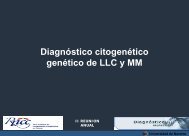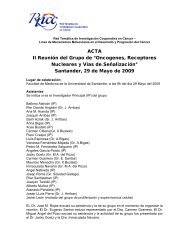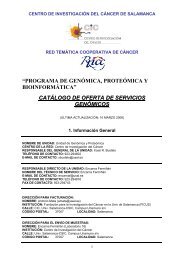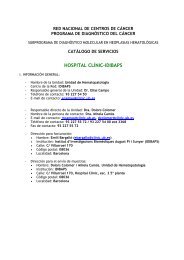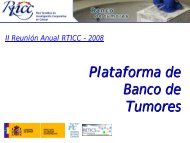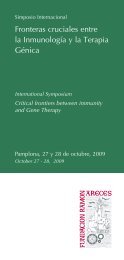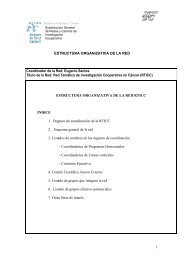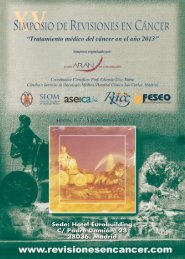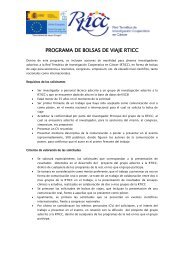Untitled - Red Temática de investigación cooperativa en cáncer
Untitled - Red Temática de investigación cooperativa en cáncer
Untitled - Red Temática de investigación cooperativa en cáncer
Create successful ePaper yourself
Turn your PDF publications into a flip-book with our unique Google optimized e-Paper software.
O-04<br />
EPIGENETIC PROFILE IN CHRONIC LYMPHOCYTIC LEUKEMIA USING METHYLA-<br />
TION-SPECIFIC MULTIPLEX LIGATION-DEPENDENT PROBE AMPLIFICATION<br />
COSIALLS AM 1 , SANTIDRIÁN AF 1 , COLL-MULET LL 1 , IGLESIAS-SERRET D 1 , GONZÁLEZ-GIRONÈS<br />
DM 1 , PÉREZ-PERARNAU A 1 , RUBIO-PATIÑO C 1 , GONZÁLEZ-BARCA E 2 , ALONSO E 3 , PONS G 1 , GIL J 1<br />
1<br />
DEPARTAMENT DE CIÈNCIES FISIOLÒGIQUES II, INSTITUT D’INVESTIGACIÓ BIOMÈDICA DE BELL-<br />
VITGE (IDIBELL)-UNIVERSITAT DE BARCELONA, L’HOSPITALET DE LLOBREGAT, BARCELONA, SPAIN<br />
(RD06/0020/0097)<br />
2<br />
DEPARTAMENT D’HEMATOLOGIA CLÍNICA, IDIBELL-INSTITUT CATALÀ D’ONCOLOGIA, L’HOSPITALET<br />
DE LLOBREGAT, BARCELONA, SPAIN (RD06/0020/1040)<br />
3<br />
SERVEI D’HEMATOLOGIA, IDIBELL-HOSPITAL DE BELLVITGE, L’HOSPITALET DE LLOBREGAT, BAR-<br />
CELONA, SPAIN<br />
Aims: The contribution of epig<strong>en</strong>etic sil<strong>en</strong>cing mechanisms in the pathog<strong>en</strong>esis of chronic<br />
lymphocytic leukemia (CLL) has gained importance in rec<strong>en</strong>t years. However, the methods<br />
used so far are labor int<strong>en</strong>sive which makes it difficult to implem<strong>en</strong>t the methylation status<br />
assessm<strong>en</strong>t in clinical practice. Here we analyze the methylation status of 35 tumor suppressor<br />
g<strong>en</strong>es using methylation-specific multiplex ligation-<strong>de</strong>p<strong>en</strong><strong>de</strong>nt probe amplification<br />
(MS-MLPA) in CLL.<br />
Materials & Methods: DNA of 37 samples from pati<strong>en</strong>ts with CLL, 6 healthy donors and<br />
Jurkat and Ramos cells lines was analyzed by MS-MLPA.<br />
Results: Our results confirm that hypermethylation is a common and not randomly distributed<br />
ev<strong>en</strong>t in CLL, and some g<strong>en</strong>es like WT1, CDH13, IGSF4/TSLC1, GATA5, DAPK1 or<br />
RARB are hypermethylated in more than 25% of the analyzed samples. Importantly, MS-<br />
MLPA also <strong>de</strong>tected hypermethylation of some g<strong>en</strong>es not reported previously in CLL, and<br />
their methylation status was confirmed by bisulfite sequ<strong>en</strong>cing.<br />
Conclusions: These results indicate that MS-MLPA is a useful technique for the <strong>de</strong>tection<br />
of methylation in CLL samples with automated data processing at a low cost per sample.<br />
Selecting CLL-specific methylation targets in or<strong>de</strong>r to g<strong>en</strong>erate a CLL-specific MS-MLPA<br />
probe set could <strong>en</strong>hance its usefulness as a tool in studies of risk stratification and guiding<br />
the best therapeutic <strong>de</strong>cision.<br />
Observaciones: Este trabajo se ha realizado <strong>en</strong> colaboración <strong>en</strong>tre los grupos <strong>de</strong> la<br />
RTICC <strong>de</strong>l Dr. Joan Gil Santano y la Dra. Eva María González Barca (códigos <strong>de</strong> grupo<br />
RD06/0020/0097 y RD06/0020/1040).<br />
O-05<br />
CRYPTIC DUPLICATIONS AND DELETIONS TO IMPROVE RISK GROUPS IN CHILD-<br />
HOOD ACUTE LYMPHOBLASTIC LEUKEMIA<br />
LÓPEZ-LÓPEZ E 1 , PUIGGROS A 2 , PIÑAN MA 3 , NAVAJAS A 4 , SOLÉ F 2 , GARCÍA-ORAD A 1<br />
1<br />
DEPARTMENT OF GENETICS, PHYSIC ANTHROPOLOGY AND ANIMAL PHYSIOLOGY, UNIVERSITY OF THE<br />
BASQUE COUNTRY, BILBAO (RD06/0020/0048)<br />
2<br />
GROUP OF TRANSLATIONAL RESEARCH IN HEMATOLOGIC NEOPLASIAS, IMIM HOSPITAL DEL MAR,<br />
BARCELONA (RD07/0020/2004)<br />
3<br />
DEPARTMENT OF HEMATOLOGY AND HEMOTHERAPY, UNIVERSITY HOSPITAL CRUCES, BILBAO<br />
(RD06/0020/0048)<br />
4<br />
DEPARTMENT OF ONCOHEMATOLOGY, UNIVERSITY HOSPITAL CRUCES, BILBAO (RD06/0020/0048)<br />
Acute lymphoblastic leukemia (B-ALL) is the most common pediatric malignancy and a<br />
major cause of <strong>de</strong>ath by disease in childr<strong>en</strong>. Survival has increased adapting therapy to risk<br />
groups, characterized by prognostic markers that inclu<strong>de</strong> cytog<strong>en</strong>etic alterations. Therapy<br />
is int<strong>en</strong>sified in higher risk pati<strong>en</strong>ts. However, some pati<strong>en</strong>ts do not respond properly to<br />
treatm<strong>en</strong>t and have to be moved to higher risk groups. This could mean that the risk groups<br />
are not well <strong>de</strong>fined, due in part to un<strong>de</strong>tected cryptic alterations. Therefore, in this study<br />
we wanted to i<strong>de</strong>ntify novel cryptic <strong>de</strong>letions and duplications that could allow the recognition<br />
of the pati<strong>en</strong>ts that may be receiving less treatm<strong>en</strong>t than they need.<br />
Methods<br />
We analyzed DNA samples from 23 pati<strong>en</strong>ts diagnosed with B-ALL from the differ<strong>en</strong>t risk<br />
groups (7 standard risk, 10 high risk, 1 very high risk, and 5 that changed risk). We used the<br />
Cytog<strong>en</strong>etics Whole-G<strong>en</strong>ome 2.7M platform (Affymetrix) and Chromosome Analysis Suite<br />
program.<br />
Results<br />
Some recurr<strong>en</strong>t aberrations were pres<strong>en</strong>t in pati<strong>en</strong>ts from differ<strong>en</strong>t risk groups and may be<br />
associated with the leukemic process (<strong>de</strong>letions at 1q42.3, 3q13.2, 3q26.3, 3p14.2, 7q34,<br />
8q12.1, 9p21.3, 12p13.2, 14q11.2, 17q21.3, 22q11.2). Interestingly, we <strong>de</strong>tected new recurr<strong>en</strong>t<br />
aberrations that distinguish the standard risk (7p14.1 and 14q24.2 <strong>de</strong>letions) and<br />
high risk pati<strong>en</strong>ts (12q23.1 <strong>de</strong>letion). We also <strong>de</strong>tected alterations (1q21.3 and 1q25.1 duplication,<br />
5q33.3 alteration, 10q25.1-q25.2 and 12q12 <strong>de</strong>letion) that distinguish standardrisk<br />
pati<strong>en</strong>ts who remain in this group from those who were changed to high-risk. These alterations<br />
could be used to improve risk groups classification and treatm<strong>en</strong>t individualization.<br />
Conclusions<br />
Risk groups classification could be improved in pati<strong>en</strong>ts with pediatric B-ALL through the<br />
analysis of new cryptic <strong>de</strong>letions and duplications.This project was supported by RETICS<br />
(RD/06/0020/0048), Basque Governm<strong>en</strong>t (GIC10/71, SAI10/03 and 2006111015) and UPV/<br />
EHU (UFI11/35). Support by SGIker (UPV/EHU) is gratefully acknowledged.<br />
20 21



